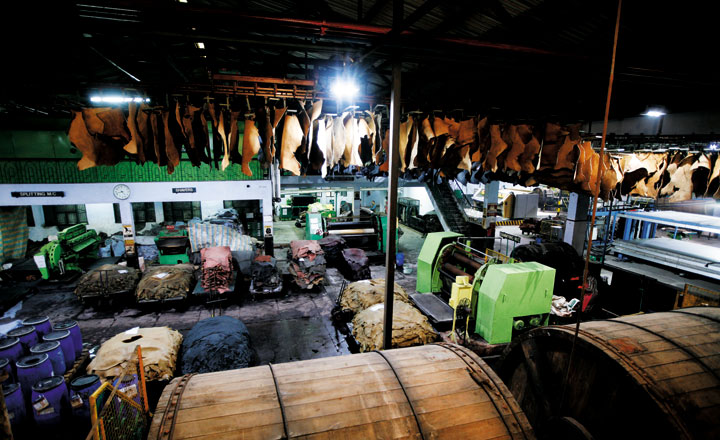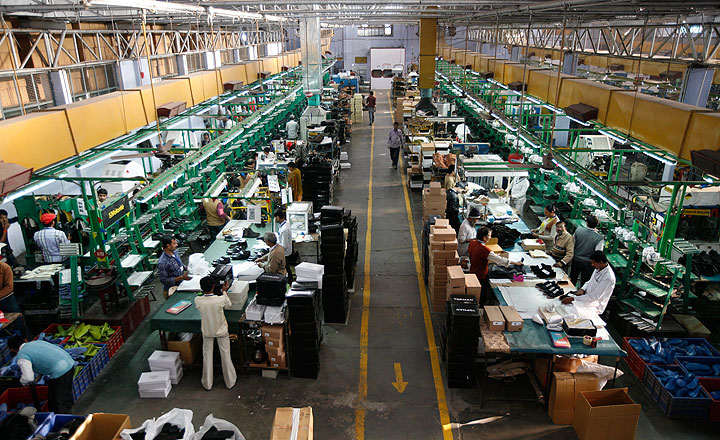Horse replicas, a floor filled with saddles and an overhead assembly line with moving hides greets us at King’s Leather. We are in the leather belt of India at Kanpur-Unnao with Taj Alam, who was the former president of UP Leather Industry Association. Alam is also the owner of King’s Leather, which exports saddles, pet accessories, gun covers, holsters and hunting accessories. “Almost the entire Rs.1,000-crore of saddle exports happen from Kanpur,” says Alam. But despite the monopoly, the industry has fallen on hard times due to slowing exports.
“These are bad times,” says Mohammed Iftikhar, owner of tanning and shoe-making company, Ruksh International, in Kanpur. “In 2015, business was down 25% for the industry and exports had dropped badly,” elaborates Iftikhar, who is also the regional chairman of the Council of Leather Exports (CLE).
Across the cluster, there are similar woes being voiced, with factory owners saying the industry has fallen prey to global woes. Or as Alam says, “The culprit is what’s changed beyond India’s shores.”
A total of 3,738 units operate in this belt and account for 34% of leather exports. Leather and finished leather goods exports stood at Rs.8,000 crore in FY15. Amid the downturn, finished leather exports was hit more than shoe exports and other goods.
Global hangover
The Kanpur-Unnao cluster is highly dependent on Europe. Developed by the British during colonial times, it is yet another legacy left behind. But with orders falling from both Europe and the US, things are not looking good for this cluster that is entirely dependent on exports.
“One of my customers from the US reduced orders by 50% last year. We used to operate on all days but now we keep the machines shut during the weekend,” says Ashraf Rizwan, CEO of Homera Dyeing, a tannery and shoe upper making company, not very far from Iftikhar’s factory. Homera’s exports stood at Rs.140 crore last year. Rizwan is expecting de-growth of around 15% in FY16.
 Besides, subdued oil prices have impacted demand from Russia, another significant contributor to exports from this cluster. “The Russian economy is dependent on oil exports but with prices falling, their currency has devalued vis-à-vis the dollar. They can’t survive without leather but are now looking to source from within the Commonwealth of Independent States.”
Besides, subdued oil prices have impacted demand from Russia, another significant contributor to exports from this cluster. “The Russian economy is dependent on oil exports but with prices falling, their currency has devalued vis-à-vis the dollar. They can’t survive without leather but are now looking to source from within the Commonwealth of Independent States.”
It’s not just small players within the cluster that have been affected but large ones too. “Demand is definitely down, especially from Europe, which had mild winters,” says Mukhtarul Amin, chairman, Superhouse Group, the largest employer in the region with 8,000 workers. The Rs.800-crore exporter, which counts high-street brands such as Diesel, Mango, Zara and Benetton amongst its buyers, says it is looking at a de-growth of 10% this year.
Currency wars
“Devaluation of Brazilian real and Chinese yuan has contributed significantly to what has happened in our cluster,” adds Alam. Brazil’s currency has depreciated more than 40% vis-a-vis the US dollar compared to end-2014 while China has devalued the yuan by 3% in 2015. Thus not only are the Brazilian exporters more competitive in terms of price, higher Real realisation has also resulted in exporters investing back in the business making themselves more competent. There is also another reason people are drifting towards Brazil. You get cow leather in Brazil, which is of a superior quality than buffalo leather available in India.
The Chinese, Alam says, have devalued their currency to combat rising labour costs. Emergence of Bangaldesh and Vietnam as cheaper go-to destinations has also impacted the industry. “Even high-street bands are pressing for price reduction,” says Amin.
Back home
While global issues are much to blame, there is pressure on the home front too. Amin says that raw material costs (of hides) have escalated (25%) in last one year. “There has been shortage too,” he adds. One of the reasons is the monopoly of slaughterhouses in Kanpur and cartelisation in the area.
Pointing out some of the inherent structural flaws, Rakesh Suri, owner of Suri Shoes says, “Though we have the largest population of cattle in the world, buffaloes are reared for milk or meat. Skin is a byproduct of the meat export industry”. Usually, slaughterhouses remove the hide and send the entire animal out for export. In mature markets, intensive processing takes place at the slaughtering end.
Besides, frequent run-ins with the National Green Tribunal (NGT) have only added to the industry’s woes. Over the years, the leather industry has faced growing flak for polluting water bodies, especially the Ganga river. In 2015, NGT cracked down on 700 units and 98 units (mostly small) were shut down for some time. These units are operational now.
While the industry terms NGT action unfair, pointing to the absence of a bigger treatment facility, most tanners have accepted it is in their own interest to get effluents treated rather than face NGT action every six months.
The currently operational common effluent treatment plant (CETP) was built in 1987 at the behest of the Supreme Court. It was India’s first CETP but has been upgraded just once in 1994. The plant has the capacity to handle a flow of 9 million litres per day (MLD) while what is required is a 32 MLD plant. No quick solutions seem to be in the offing for any of these issues.

Not all bad
But even amid the crisis, some like Amin think it’s not all bad or an irreversible crisis for the industry. “One good thing is we are diversified. We have buffalo leather, calf leather, goat leather, saddlery, safety shoes, accessories,” he says.
To tide over hard times, companies are strengthening their R&D, controlling costs and some like Amin are even buying distribution companies abroad. Superhouse Group recently bought Linea De Seguridad S.L. in Arnedo, Spain.
Suri, who has some potential foreign customers at his factory for a tour, admits to the downturn but says, “It’s not doomsday for industry yet. There is hope. We had two years of a good run earlier so additional capacity got created.” “People are trying to get away from China as their factories are moving up the value chain and manufacturing is becoming costlier. But factories here are not geared for the kind of volume that China has been providing American companies,” he adds. Suri Shoes plans to ramp up capacity by 50% from the current 100,000 pairs per month. But within the cluster, people point to idle capacity now, with some factories operating at 60% of overall capacity.
Where most people in the cluster are cautious and worried, there is one guy who has logged growth even in these tough times. Stepping into Rajendra Jalan’s Arvind Footwears’ factory feels like stepping into a Texas town, only without the cowboys. Wherever you see, there are boots stacked over racks, with more being stitched, cut and finished by the workers. “About 50% of my revenue is contributed by the US market, where we focus mainly on cowboy boots for women,” he says. The company is expected to top last year’s revenue of Rs.100 crore, with 4-5% growth this year. “We are operating in a global village and must be ready for everything. I think in nine months, growth will be back,” Jalan says. According to him, the biggest downturn is in leather exports and it will force many tanners to look at the domestic market.
More leather?
Meanwhile, the government wants to increase production of leather and leather goods from $8 billion currently to $25 billion by 2020. Alam thinks this is a very ambitious target. “We would require 10 billion sqft of leather to be produced compared to the current 2 billion square feet. To reach there, we would need organised animal breeding across the country and new leather clusters. Eight clusters were proposed but due to concerns over pollution, not one has come up,” he says. And environmental bodies are in no hurry to green flag more.
While the Kanpur-Unnao cluster doesn’t face any power issues, as industrial feeders are reliable in most areas, infrastructure issues, especially bad roads, take a toll. “The cost of sending a container from Kanpur to Mumbai port is Rs.40,000 per container and then to Europe is only Rs.15,000 per container,” says Suri, adding that high transaction costs at every stage are impacting companies. The government may have sounded the gong on ‘Make in India’ now, but this belt has already been doing this for years. Stuck in doldrums now, it is looking for some support.
The industry is also taking steps to reduce its reliance on exports by focusing on the home market. “In the next 15 years, we have to ‘Make for India’ from here. The retail part remains challenging but once e-commerce players such as Flipkart, Amazon settle down, the unorganised footwear market can get more organised,” says Suri. On his part, he has started a footwear brand – Urban Country – last year. As they say, the journey of a thousand miles begins with a single step.











